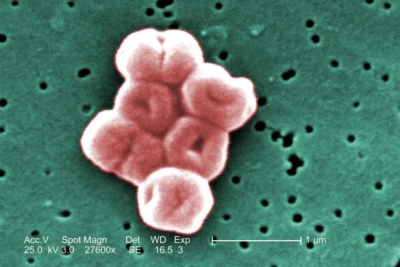
Using an innovative screening method, USC researchers have discovered that an old antibiotic is a powerful tool against one of the most drug-resistant causes of infection among hospitalized patients. (Photo/Matthew J. Arduino, Centers for Disease Control and Prevention)
USC researchers have discovered that an old antibiotic may be a powerful new tool against a deadly superbug, thanks to an innovative screening method that better mimics conditions inside the human body.
The antibiotic rifabutin is “highly active” in fighting multidrug-resistant Acinetobacter baumannii, a significant cause of life-threatening infections in medical facilities, researchers found.
The study appears today in Nature Microbiology.
“Rifabutin has been around for more than 35 years, and no one has ever studied it for Acinetobacter infections before,” said first author Brian Luna, assistant professor of molecular microbiology and immunology at the Keck School of Medicine of USC. “Going forward, we may find many new antibiotics that have been missed over the last 80 years because the screening tests used to discover them were suboptimal.”
Tuberculosis antibiotic finds second life as superbug treatment
Rifabutin is used to treat tuberculosis, especially in people with HIV/AIDS who can’t tolerate the drug rifampin. It is on the World Health Organization’s Model List of Essential Medicines, the safest and most effective medicines needed in a health system.
Until now, it hadn’t been tried against A. baumannii, which emerged during the Iraq War as a troop-killing superbug in military treatment facilities. Acinetobacter causes pneumonia, meningitis and bloodstream infections; patients tend to require lengthy hospital stays and invasive devices like catheters and ventilators.
Each year, A. baumannii is responsible for about 2% of the 99,000 U.S. deaths from hospital-acquired infections, according to the Centers for Disease Control and Prevention.
One reason rifabutin’s superpower against superbugs was overlooked is because of current screening techniques, researchers said. Since the 1940s, new or existing antibiotics have been tested against bacteria grown in “rich culture media,” a nutrient-packed broth or gel that speeds up the process by making bacteria grow rapidly.
“But bacteria grow very differently inside the human body,” said Brad Spellberg, chief medical officer at the Los Angeles County+USC Medical Center and senior author of the study. As such, the team designed a new type of “nutrient-limited” media that better mimics conditions inside the body. They hypothesized that the more realistic media might unmask antibiotics with hidden strengths.
Rifabutin proves effective as Acinetobacter treatment
They found that rifabutin was vigorously active against A. baumannii grown in the nutrient-limited media — as well as in animal tissue — but not effective against bacteria grown in the more commonly used media.
The scientists discovered that rifabutin uses a unique “Trojan horse” strategy to trick the bacteria into actively importing the drug inside itself, bypassing the bacterial outer cell defenses. This “pump” that imports the drug is only active in the more human-like media. In traditional rich culture media, high levels of iron and amino acids suppress the pump’s activity, researchers found.
“Rifabutin can be used immediately to treat such infections because it is already FDA-approved, cheap and generic, and on the market,” Spellberg said. “But we would like to see randomized controlled human trials to prove its efficacy, so we know for sure one way or the other.”
— By Leigh Hopper
In addition to Spellberg and Luna, other authors of the study are Bosul Lee, Amber Ulhaq, Jun Yan, Peggy Lu, Jiaqi Cheng, Travis Nielsen, Juhyeon Lim, Warisa Ketphan, Hyungjin Eoh, Rosemary She and Nicholas Skandalis, all of the Keck School of Medicine of USC; Malina Bakowski and Case McNamara of Calibr, Scripp Research Institute, in La Jolla; and Vincent Trebosc, Christian Kemmer, Sergio Lociuro and Glenn Dale of BioVersys AG in Basel, Switzerland.
The study was supported by the National Institute of Allergy and Infectious Diseases (grants R01AI139052, R01AI130060 and R01AI117211 to BS), the Food and Drug Administration (BAA Contract HHSF223201710199C) and the Bill & Melinda Gates Foundation (OPP1107194).
Disclosures: Luna, Spellberg and Nielsen own equity in ExBaq, which is developing rifabutin in an intravenous form for clinical use. USC has a financial interest in ExBaq. Dale, Trebosc, Kemmer and Lociuro own equity in BioVersys AG, a biopharmaceutical company.